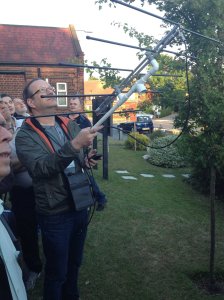JoAnne Maenpaa K9JKM wrote this article on how to use the Packet Radio Digipeater on the International Space Station (ISS) on 145.825 MHz FM. See http://tinyurl.com/K9JKM-ISS-Packet-Radio
Mineo Wakita JE9PEL has produced an Easy Guide to UI-View32 and UISS
http://www.ne.jp/asahi/hamradio/je9pel/ui32uiss.htm
Essex Ham Guide – Making Contact With The ISS via Packet Data http://www.essexham.co.uk/iss
Doug Cook KD5PDN‘s article about contacting the International Space Station with a few watts and a shoestring budget antenna is now available.
The article “QRP to the ISS” appeared in the February, 2012 issue of QST magazine and, with permission from the ARRL, can be downloaded from Clint Bradford K6LCS’s website.
Doug walks the reader through building a simple tape measure beam, and how to successfully work the ISS with it and a handheld radio.
Read the article at http://www.work-sat.com/Antennas_files/QRP-ISS.pdf
A video by author Doug Cook KD5PDN shows the tape rule antenna and how to set up a Yaesu VX-8R for ISS APRS packet data sending and receiving and other aspects to make a digital contact with the International Space Station. You can also learn how to interpret the audio prompts when packet data is being received.
Watch ISS APRS contact with a Yaesu VX-8R WB5BSA
There is lots of other information on the Work Satellites website at http://www.work-sat.com/
How to show up on an APRS map by Bob Bruninga WB4APR http://www.aprs.org/iss-aprs/issicons.html
How to hear the ISS https://amsat-uk.org/beginners/how-to-hear-the-iss/
ISS Tracking / Predictions https://amsat-uk.org/beginners/satellite-tracking/
Almost any 144 MHz FM rig will receive the ISS, you can even use a general coverage VHF scanner with an external antenna. As far as the antenna is concerned the simpler the better. A ¼ wave ground plane has a high angle of radiation and works well. Large 144 MHz colinears are not as good because the radiation pattern is concentrated at the horizon while the ISS is above 15 degrees elevation for most of a pass.
You can receive the ISS outdoors using a 144 MHz hand-held with its helical antenna but a 1/4 wave whip will give far better results.
In the UK we use narrow 2.5 kHz deviation FM but the ISS transmits using the wider 5 kHz deviation used in much of the world. Most rigs can be switched been wide and narrow deviation filters so select the wider deviation. Hand-held rigs all seem to have a single wide filter fitted as standard.

You must be logged in to post a comment.